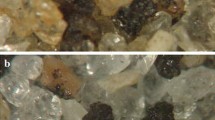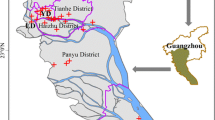Abstract
Soil-like waste products such as construction and demolition debris fines, street sweepings and catch basin sediments often contain elevated concentrations of polycyclic aromatic hydrocarbons (PAHs) resulting from anthropogenic activities. Previous research suggested that small pieces of asphalt may contribute to PAHs in these wastes. The objective of this research was to investigate this idea by analyzing total PAHs concentrations in various asphalt products to assess their contribution to PAHs in these wastes. Five types of asphalt products (new and used asphalt shingles, new asphalt pavement, reclaimed asphalt pavement [RAP], and bitumen) were selected. PAHs concentrations were relatively low in most of the asphalt products except for RAP. The benzo[a]pyrene-equivalent (BaP-equivalent) concentrations in two RAP samples exceeded both Florida and EPA risk thresholds. PAHs bioaccessibility tests were conducted using a mild solvent extraction method on asphalt product samples of several different samples sizes (< 0.5 cm and < 250 µm); bioaccessibility was measured at < 10% for most samples. When asphalt products were mixed with clean sand to mimic soil-like waste, PAHs concentrations and bioaccessibility for most products decreased with decreasing asphalt percentages. Though PAHs sources for asphalt products are petrogenic, the few detected diagnostic ratios did not indicate a clear petrogenic source for these materials, suggesting that caution be taken when using diagnostic ratios for source apportionment related to these materials.
Article Highlights
-
Polycyclic aromatic hydrocarbon (PAH) in asphalt products were analyzed.
-
Asphalt products have been a suspected source of PAH in soil-like wastes.
-
PAH concentrations were found to be low in most asphalt products.
-
Asphalt does not appear to be a significant source of PAH in soil-like wastes.

Similar content being viewed by others
References
Abdel-Shafy HI, Mansour MSM (2016) A review on polycyclic aromatic hydrocarbons: source, environmental impact, effect on human health and remediation. Egypt J Pet 25:107–123
Allan IJ, O’Connell SG, Meland S, Bak K, Grung M, Anderson KA, Ranneklev SB (2016) PAH accessibility in particulate matter from road-impacted environments. Environ Sci Technol 50(15):7964–7972
Azah E (2011) The impact of polycyclic aromatic hydrocarbons (PAHs) on beneficial use of waste materials. ProQuest LLC
Azah E, Kim H, Townsend T (2015) Source of polycyclic aromatic hydrocarbon in roadway and stormwater system maintenance residues. Environ Earth Sci 74:3029–3039
Biache C, Mansuy-Huault L, Faure P (2014) Impact of oxidation and biodegradation on the most commonly used polycyclic aromatic hydrocarbon (PAH) diagnostic ratios: implications for the source identifications. J Hazard Mater 267:31–39
Brandli RC, Bucheli TD, Kupper T, Mayer J, Stadelmann FX, Tarradellas J (2007) Fate of PCBs, PAHs and their source characterostic ratios during composting and digestion of source-separated organic waste in full-scale plants. Environ Pollut 148:520–528
Brandt HCA, Groot PCD (2001) Aqueous leaching of polycyclic aromatic hydrocarbons from bitumen and asphalt. Water Res 35(17):4200–4207
Brantley AS, Townsend T (1999) Leaching of pollution from reclaimed asphalt pavement. Environ Eng Sci 16(2):105–116
Colombo JC, Pelletler E, Brochu C, Kjalll M (1999) Dertermination of hydrocarbon sources using n-alkane and polyaromatic hydrocarbon distribution indexes. Case study: Rio de La Plata Estuary, Argentina. Environ Sci Technol 23:888–894
Cui X, Xiang P, He R, Juhasz A, Ma LQ (2016) Advances in in vitro methods to evaluate oral bioaccessibility of PAHs and PBDEs in environmental matrices. Chemosphere 150:378–389
Duan L, Palanisami T, Liu Y, Dong Z, Mallavarapu M, Kuchel T, Semple KT, Naidu R (2014) Effects of ageing and soil properties on the oral bioavailability of benzo[a]pyrene using a swine model. Environ Int 70:192–202
Fang GC, Chang KF, Lu C, Bai H (2004) Estimation of PAHs dry deposition and BaP toxic equivalency factors (TEFs) study at urban, industry park and rural sampling sites in Central Taiwan, Taichung. Chemosphere 55(6):787–796
Fernandes PRN, Soares SA, Nascimento RF, Soares JB, Cavalcante RM (2009) Evaluation of polycyclic aromatic hydrocarbons in asphalt binder using matrix solid-phase dispersion and gas chromatography. J Chromatogr Sci 47:789–793
Gomez-Eyles JL, Jonker MTO, Hodson ME, Collins CD (2012) Passive samplers provide a better prediction of PAH bioaccumulation in earthworms and plant roots than exhaustive, mild solvent, and cyclodextrin extractions. Environ Sci Technol 46:962–969
Hussar E, Richards S, Lin ZQ, Dixon RP, Johnson KA (2012) Human health risk assessment of 16 priority polycyclic aromatic hydrocarbons in soils of Chattanooga, Tennessee, USA. Water Air Soil Pollut 223(9):5535–5548
Johnsen AR, Lipthay JR, Reichenberg F, Sorensen SJ, Andersen O, Christensen P, Binderup M, Jacobsen CS (2006) Biodegradation, bioaccessibility, and genotoxicity of diffuse polycyclic aromatic hydrocarbon (PAH) pollution at a Motorway site. Environ Sci Technol 40:3293–3298
Katsoyiannis A, Terzi E, Cai QY (2007) On the use of PAH molecular diagnostic ratios in sewage sludge for the understanding of the PAH sources. is this use appropriate? Chemosphere 69:1337–1339
Lee BK, Vu VT (2010) Sources, distribution and toxicity of polycyclic aromatic hydrocarbons (PAHs) in particulate matter. In pollution, InTech
Legret M, Odie L, Demare D, Jullien A (2005) Leaching of heavy metals and polycyclic aromatic hydrocarbons from reclaimed asphalt pavement. Water Res 39(15):3675–3685
Li C, Sun H, Juhasz AL, Cui X, Ma LQ (2015) Predicting the relative bioavailability of DDT and Its metabolites in historically contaminated soils using a tenax-improved physiologically based extraction test (TI-PBET). Environ Sci Technol 50:1118–1125
Liste HH, Alexander M (2002) Butanol extraction to predict bioavailability of PAHs in soil. Chemosphere 46(7):1011–1017
Liu Y, Gao P, Su J, da Silva EB, de Oliveira LM, Townsend T, Xiang P, Ma LQ (2019) PAHs in urban soils of two Florida cities: background concentrations, distribution, and sources. Chemosphere 214:220e227
Man YB, Kang Y, Wang HS, Lau W, Li H, Sun XL, Giesy JP, Chow KL, Wong MH (2013) Cancer risk assessments of Hong Kong soils contaminated by polycyclic aromatic hydrocarbons. J Hazard Mater 261:770–776
Nisbet ICT, LaGoy PK (1992) Toxic equivalency factors (TEFs) for polycyclic aromatic hydrocarbons (PAHs). Regul Toxicol Pharmacol 16(3):290–300
Parajulee A, Wania F (2013) Evaluating officially reported polycyclic aromatic hydrocarbon emissions in the Athabascs oil sands region with a multimedia fate model. Proc Natl Acad Sci USA 111(9):3344–3349
Petry T, Schmid P, Schlatter C (1996) The use of toxic equivalency factors in assessing occupational and environmental health risk associated with exposure to airborne mixtures of polycyclic aromatic hydrocarbons (PAHs). Chemosphere 32(4):639–648
Ruby MV, Lowney YW, Bunge AL, Roberts SM, Gomez-Eyles JL, Ghosh U, Kissel JC, Tomlinson P, Menzie C (2016) Oral bioavailability, bioaccessibility, and dermal absorption of PAHs from soil—state of the science. Environ Sci Technol 50(5):2151–2164
Stogiannidis E, Laane R (2015) Source characterization of polycyclic aromatic hydrocarbons by using their molecular indices: an overview of possibilities. Rev Environ Contam Toxicol 234:49–133
Swindell AL, Reid BJ (2006) Comparison of selected non-exhaustive extraction techniques to assess PAH bioavailability in dissimilar soils. Chemosphere 62(7):1126–1134
Us EPA (2000) Hot mix asphalt plants emission assessment report. The Office of Air Quality Planning and Standards, Research Triangle Park
US EPA (2007) SW-846 test method 3550C: ultrasonic extraction. The Office of Resource Conservation and Recovery, Washington
US EPA (2014) EPA positive matrix factorization (PMF) 5.0 fundamentals and user guide. Research Triangle Park
USEPA (1984) Health effect assessment for polycyclic aromatic hydrocarbon (PAH). EPA 549/1-86-013. Environmental Criteria and Assessment Office. Cincinnati
Yunker MB, Macdonald RW, Vingarzan R, Mitchell RH, Goyette D, Sylvestre S (2002) PAHs in the fraser ricer basin: a critical appraisal of PAH ratios as indicators of PAH source and composition. Org Geochem 33:489–515
Zhang SJ, Li C, Li YZ, Zhang RR, Gao P, Cui XY, Ma LQ (2017) Bioaccessibility of PAHs incontaminated soils: comparison of five in vitro methods with Tenax as a sorption sink. Sci Total Environ 601–602:968–974
Acknowledgements
This work was funded by the Construction and Demolition Recycling Association and the Hinkley Center for Solid and Hazardous Waste Management. We thank Dr. Jodie Johnson from the University of Florida Chemistry Department for their instruments and kind help. We also thank Patrick E. Bollinger and his colleagues from Perry Roofing Contractors, the University of Florida Department of Civil and Coastal Engineering, and the ABC Supply Company for providing asphalt products.
Author information
Authors and Affiliations
Corresponding author
Ethics declarations
Conflict of Interest
On behalf of all authors, the corresponding author states that there is no conflict of interest.
Electronic supplementary material
Below is the link to the electronic supplementary material.
Rights and permissions
About this article
Cite this article
Su, J., Gao, P., Laux, S.J. et al. Contribution of Asphalt Products to Total and Bioaccessible Polycyclic Aromatic Hydrocarbons. Int J Environ Res 13, 499–509 (2019). https://doi.org/10.1007/s41742-019-00189-6
Received:
Revised:
Accepted:
Published:
Issue Date:
DOI: https://doi.org/10.1007/s41742-019-00189-6




